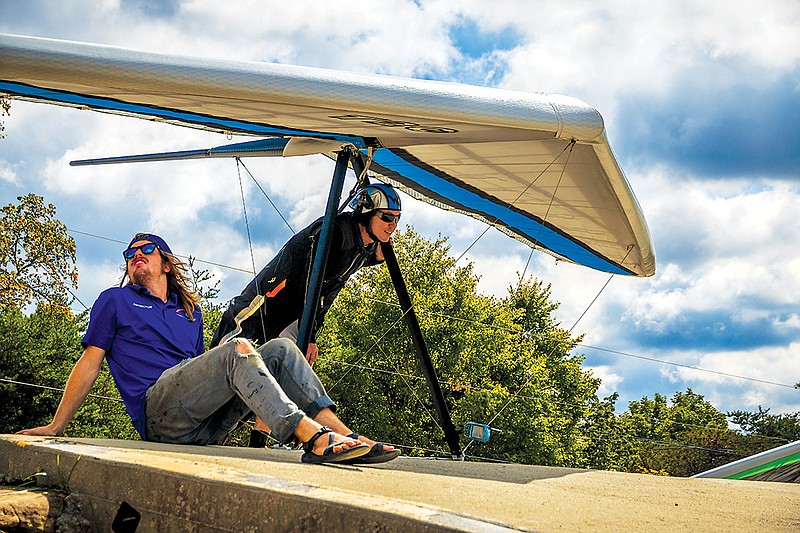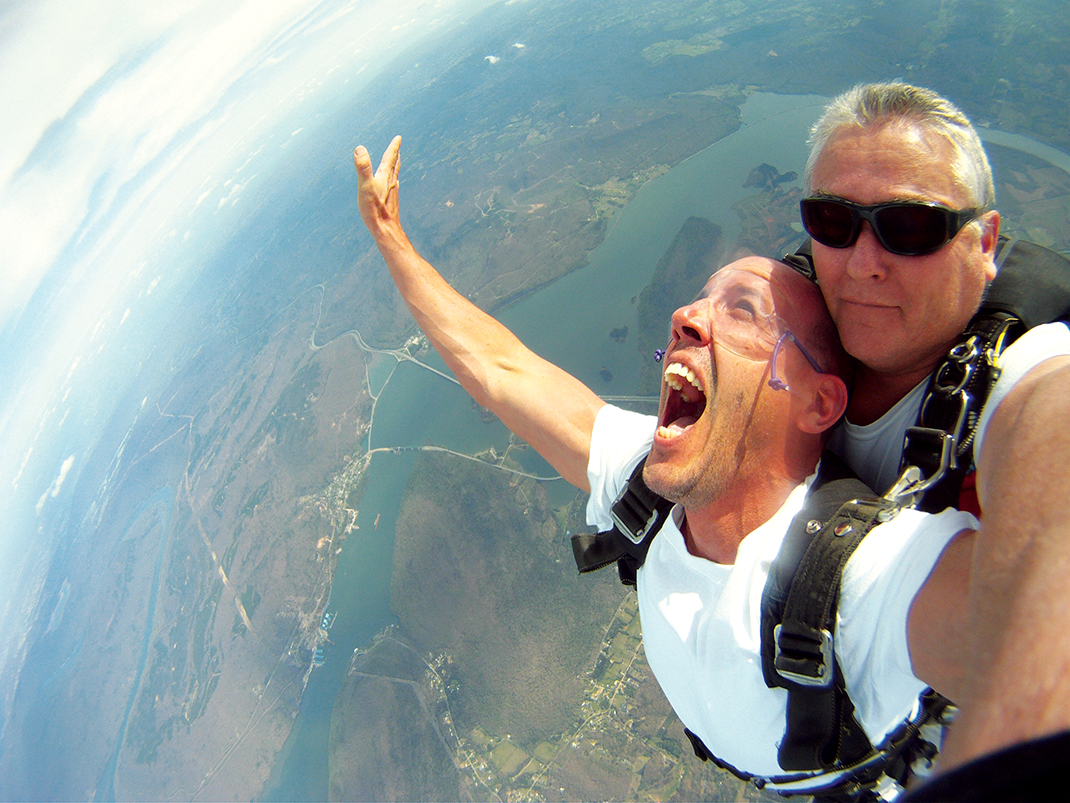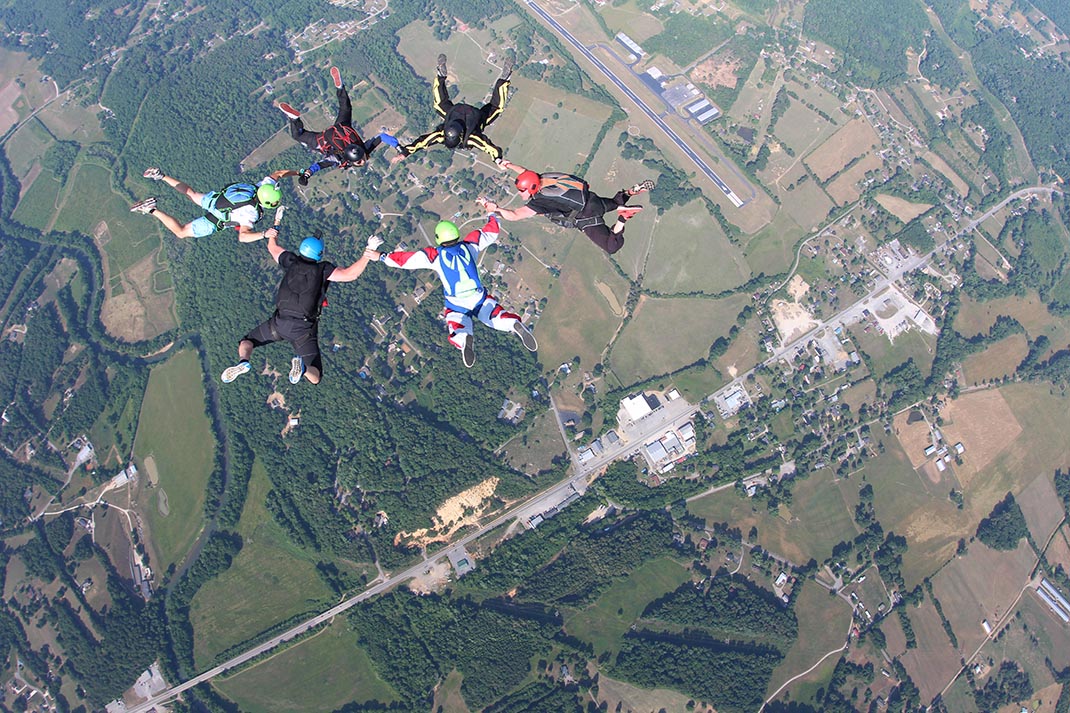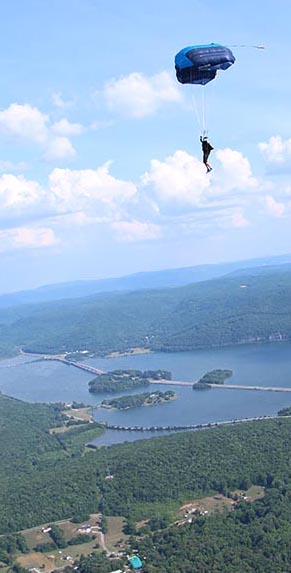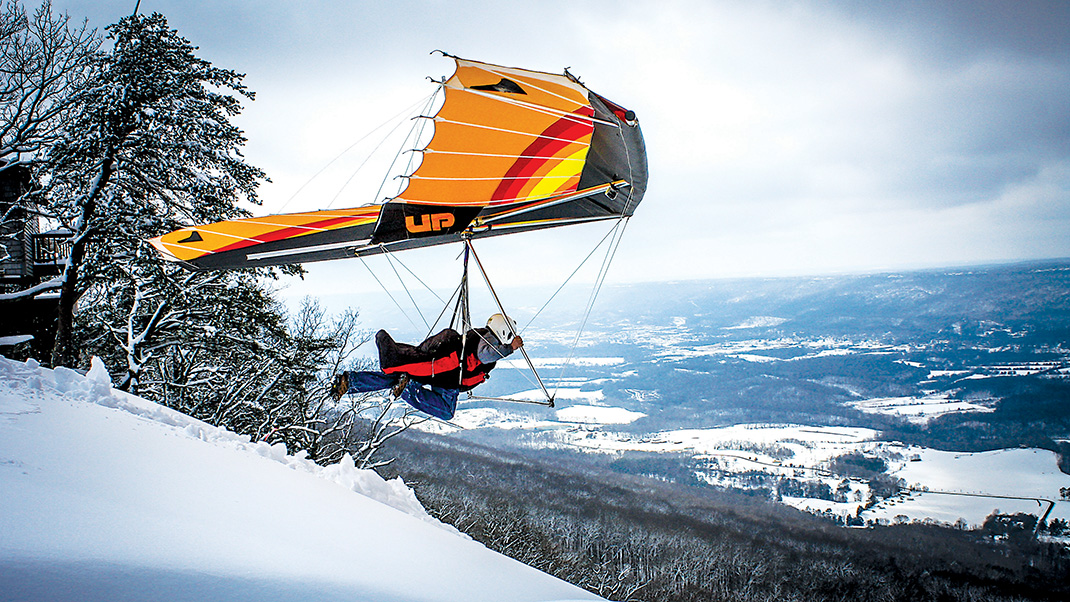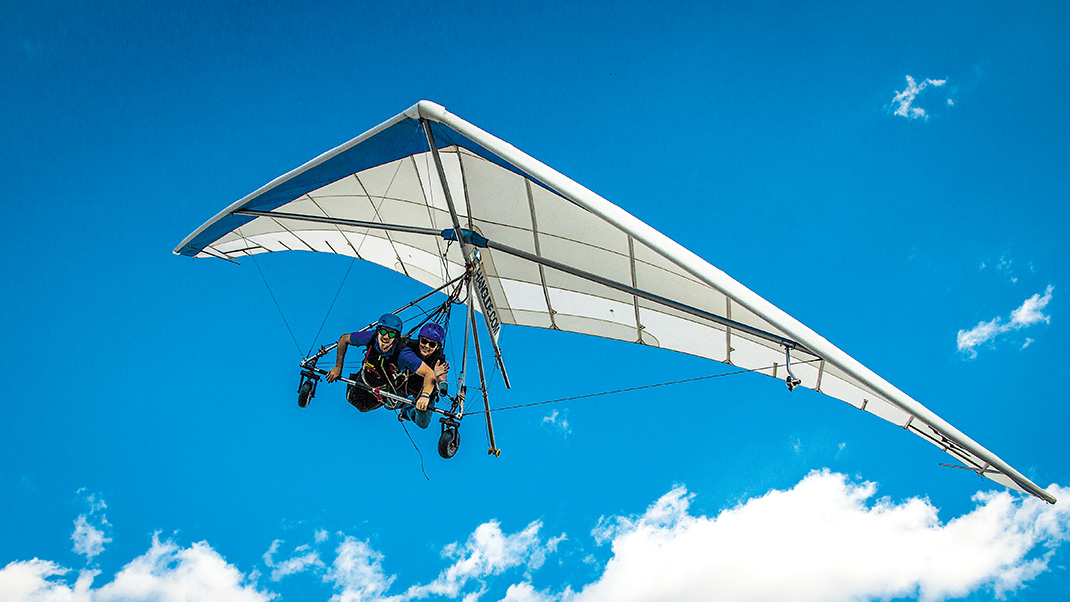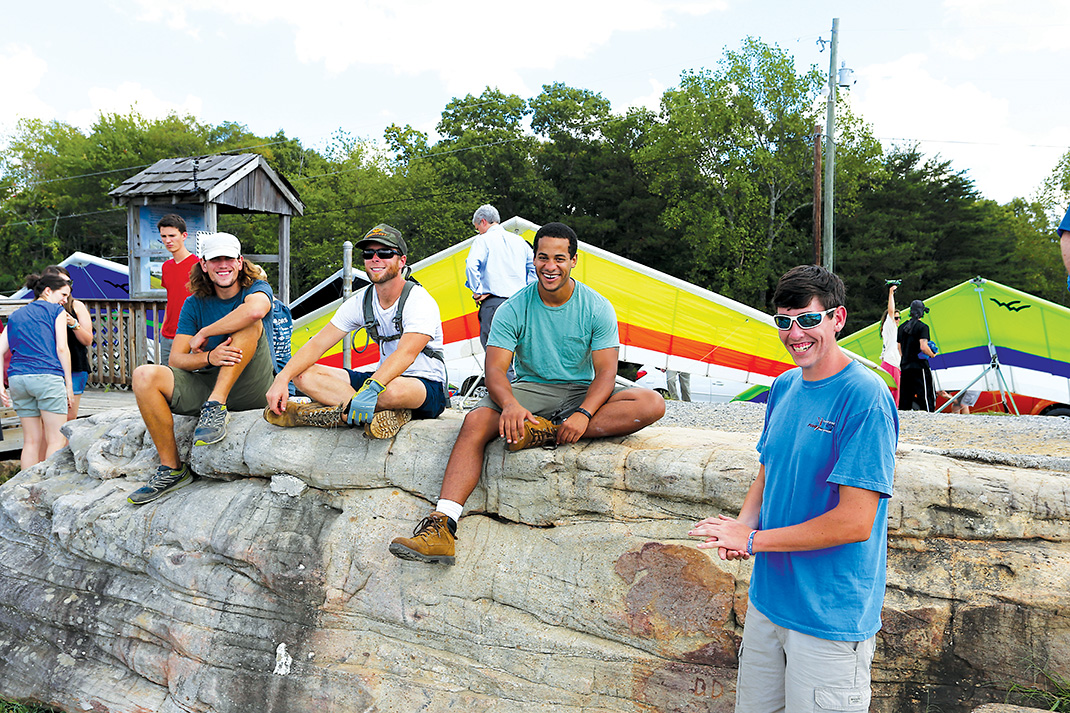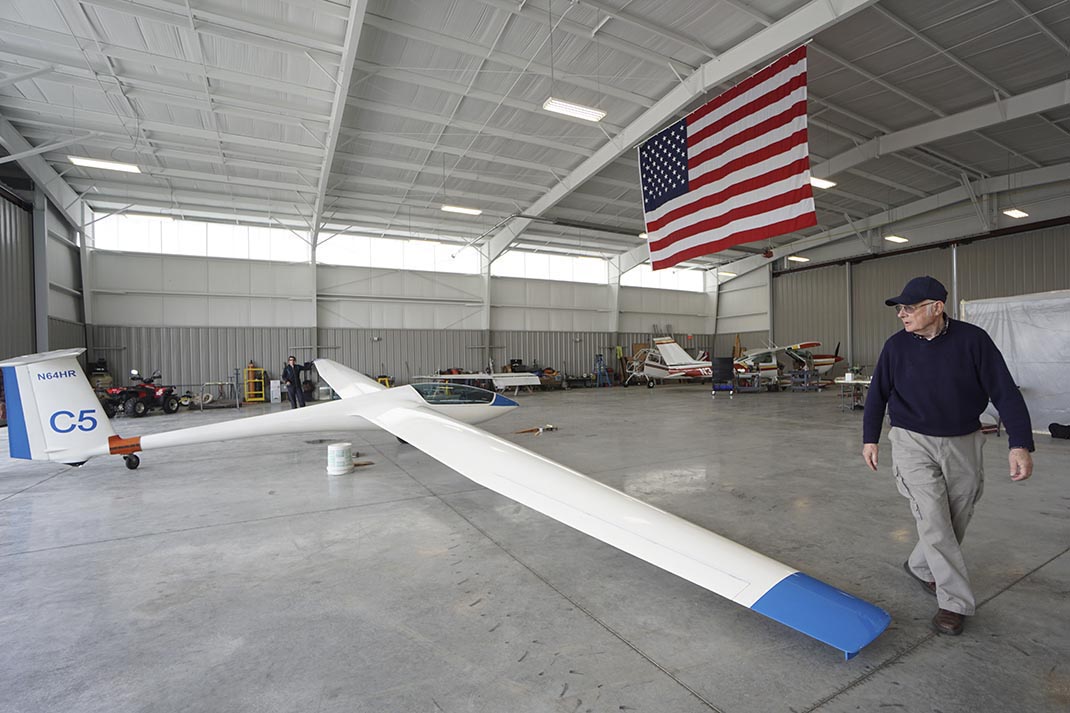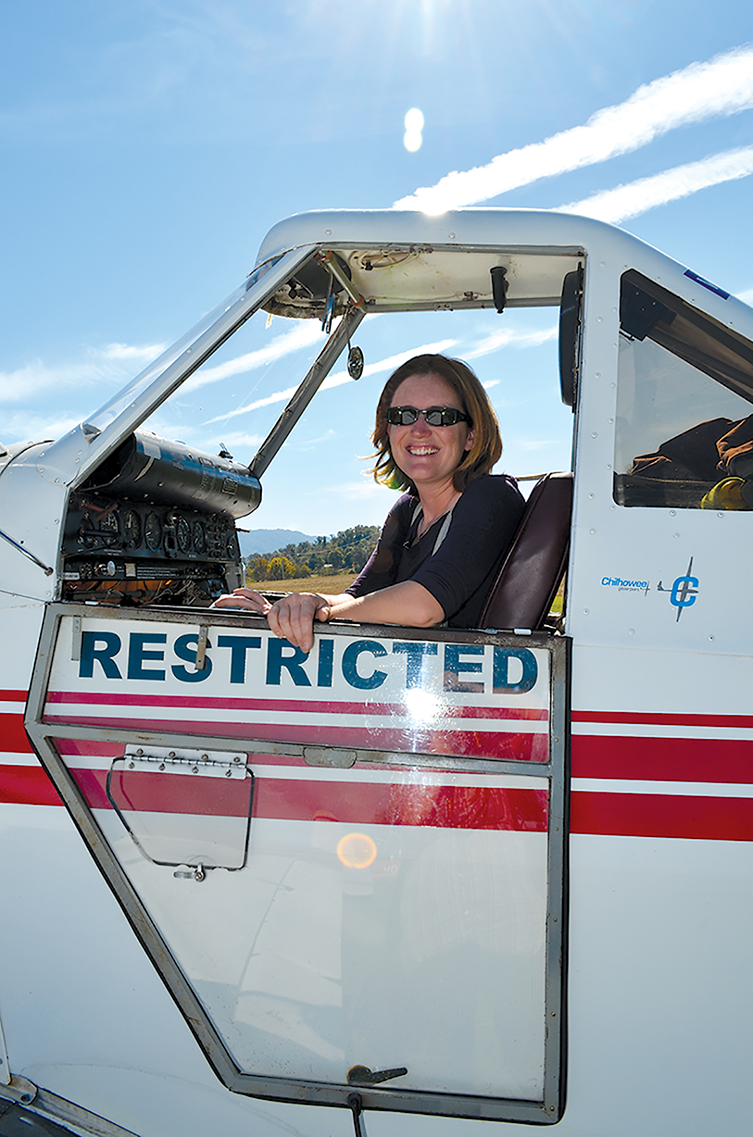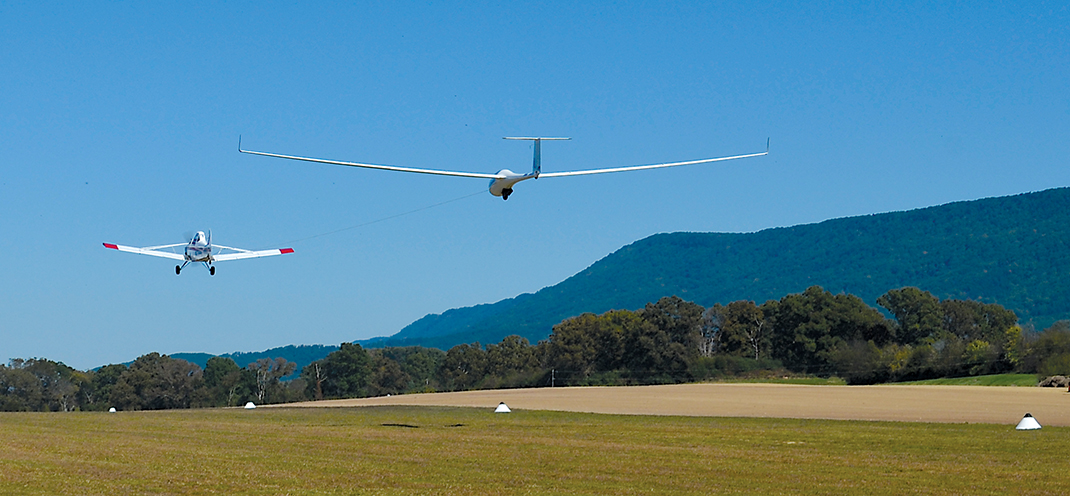Air sports practitioners know how they look to those who prefer to live life anchored to the ground.
"Like a bunch of damn hippies, man," laughs hang glider pilot Willie Vaughn, who often flies in Rising Fawn, Georgia.
But despite their high-altitude antics, they don't all have their heads in the clouds. In fact, the risky nature of their crafts requires them to be more grounded than most in order to safely brave even the most fearsome pursuits.
Each sport attracts its own diverse group of individuals who feed into the sport's distinct lifestyle, but no matter the differences in their crafts or cultures, they all have one thing in common.
"Our medium, our canvas, is the sky," says Polk County sailplane pilot Jason Arnold.
We met up with some of Chattanooga's supposed hippies to give you a look into the world of locals getting high from the sky.
Skydiving: Flight of the Fearless
While most of America's workforce is cooped up in a cubicle or making small talk by the water cooler, Lyle Stewart is flinging himself out of planes and rocketing to the ground at 120 mph.
As head tandem instructor at Chattanooga Skydiving Company in Jasper, Tennessee, the 40-year-old makes a living by strapping adventure-seekers to his chest and soothing their rattled nerves right before launching them both into a 12,500-foot drop.
While many office-dwellers would probably happily shy away from the unconventional job, Stewart flushed away a full track and field scholarship to the University of Tennessee at Chattanooga in order to pursue his high-flying dream. And like several other professional skydivers who have sacrificed scholarships and conventional careers in pursuit of the plunge, he hasn't regretted it a day since.
Each year, approximately 500,000 Americans dare to dive for the first time, the United States Parachute Association estimates, but it is those who join the nation's minuscule pool of full-time jumpers who truly experience their hidden society.
Passing glimpses of that society can be caught at Chattanooga Skydiving Co., where the close-knit staff can often be found hanging out on a couch inside the hangar or chuckling at videos of their most recent jumps. Despite their familiarity with each other, however, most haven't worked there long.
Like most skydiving facilities, the company's staff is made up of independent contractors, and like most facilities employing skydivers, Chattanooga Skydiving has a fairly high turnover rate.
"Skydivers are gypsies," says Justin Silvia, who has been skydiving for 33 years and now owns the local skydiving center. "They're restless souls. They generally can't stay in one place too long anyhow."
Luckily, the industry makes adequate accommodations for its workers' migrant tendencies. Skydivers can usually find work packing parachutes, teaching new jumpers or snapping mid-air photos of clientele at different facilities across the nation. Many skydiving operations have campgrounds with showers at their drop zones, areas designated for parachute landings. Skydivers can often live there rent-free to save a couple of dollars while they work and jump for a few weeks before moving on.
Since his first tandem jump got him hooked 21 years ago, Stewart has had a chance to live in an RV and skydive all over the country, including Hawaii, where he stayed for 11 years. His extensive travels have given him a taste of the rich culture behind the sport, or more specifically, a firsthand look at the raging parties for which skydivers have become infamous.
To ensure safe landings, drop zones are often located out in the country, meaning when jumpers punch out, they're free to bust out the kegs, crank up the music and raise hell to celebrate a day with no accidents.
"It's some of the wildest parties you'll ever see, and no one knows about it 'cause they're way out in the boonies," Stewart laughs. "Skydivers tend to party harder than anyone else. Hence the reason you have to blow in a tube before you go skydiving."Every drop zone around the country parties differently, Stewart notes. Some have a strong nude culture, with jumpers stripping down as they let loose around the bonfire; while others favor parties in the sky, blaring bluegrass music as they hurtle back to earth, he says.
Among Stewart's favorite type of get-togethers are "boogies," where skydivers from all over gather to jump out of specialty aircraft such as hot air balloons, helicopters and airplanes that open from the tailgate. Some of the more extreme stunts Stewart has pulled during such free-fall fiestas include filling a tennis ball with lead so he and his buddies could play catch mid-air, and getting a bunch of friends into an inflatable raft, then launching it out the tailgate of a plane while they held on for dear life.
"A lot of people live a life based on fear. They see something scary and they step back," the tandem instructor says. "But skydivers, in general, see something dangerous and they're like, 'Aw, yeah, cool! Lets go try it!'"
At Chattanooga Skydiving Co., the drop zone culture is a little more conservative, Stewart says, though the local jumpers have been known to throw an impressive barbecue or two at nearby Marion County Park. But at the end of the day, he adds, it isn't the wild parties, the freedom to travel or even the adrenaline rush that keeps full-time skydivers tethered to the sport. It's the underlying camaraderie.
As a veteran of the U.S. Army, serving from 1998-2001, Stewart has experienced the strong bond between brothers-in-arms. Based on his own experience, he says, the camaraderie between skydivers is stronger, mostly because of the jumpers' warmth towards each other.
"Say, for instance, we have someone land off the airfield. [Skydivers would be] like, 'Oh no! Let's get in the truck and go get him!' If you're surrounded by a bunch of military guys, they'll be like, 'Ah, he'll be fine. Let him walk back!'" Stewart explains with a laugh. "So there's a little more concern for others' safety among skydivers."Along with skydiving's similarity to paratrooping, the term for when soldiers parachute out of military aircraft, that familiar bond could be one of the reasons military personnel are so often drawn to the sport. Eleven percent of the United States Parachute Association's members are active military, making that the most common occupation among the association's ranks.
The bond between skydivers is strengthened by the fact that the number of full-timers are few - so few that Stewart compares the chances of meeting another skydiver on the street to finding someone else who can read minds, making each encounter at drop zones opportunities to form lifelong friendships.
"I'm closer to some of those people than my own family members," admits Silvia. "It's a close fraternity. Everybody knows each other. Everywhere you go, you know somebody that knows somebody."
Those connections are valuable not just because these skydivers have found others who party as hard as they do or share their love of the sky, but also because they've found others who live a life without fear.
"I think people who don't live their lives based on fear end up having more fun in life," Stewart says. "They end up being skateboarders or snowboarders or skiers or skydivers, and they don't care if they get hurt at the expense of having fun and living life."
Hang Gliding: Students of the Sky
With wavy, shoulder-length blond hair and a scruffy goatee, Willie Vaughn is the stereotypical image of what most expect those who surf the sky to look like.
Wearing a pineapple-dotted cap, black swim trunks and a crumpled blue polo shirt reading "Instructor," the 21-year-old greets visitors at Lookout Mountain Hang Gliding, formerly Lookout Mountain Flight Park, with a genuine toothy grin. Almost everything about him is easy-going, from his tone to his posture - but ask him how to spot the perfect hang gliding conditions, and he'll break down air current and wind direction just as well as any meteorologist.
That's because for pilots who make the sport look effortless, hang gliding isn't just about surfing the skies; it's about studying them.
There are lots of misconceptions about hang gliding, says Vaughn. One is that the pilots are all free spirits, when, in reality, the extreme sport attracts a diverse group ranging from those who fit that description to men and women who would look right at home in a corporate office. Another misconception, Vaughn adds, is that hang gliding is an extreme sport at all.
Despite regularly soaring at altitudes between 5,000 and 10,000 feet, some hang glider pilots - believe it or not - are uncomfortable with heights. Vaughn himself is a little uneasy atop roofs and scaffoldings, because he knows there's a possibility of falling. But when his wings are on his back and he's held secure by the harness around his waist, he knows there's very little chance of falling. In fact, the hang gliding experience is actually more relaxing than most would think, he says.
"It's not very extreme unless you make it extreme," Vaughn explains. "It's just like riding your bike; you can cruise leisurely down the sidewalk, just use it as a way to clear your mind, or you can get into downhill mountain biking and get really crazy with it."
Those looking to "get really crazy with it" usually find no shortage of heart-pounding stunts to test the limits of their courage. They fly in tumultuous conditions for a wild ride, whoosh near solid objects to show off their skill, and perform daring maneuvers, from simple loops to prolonged upside-down flights.
Others, however, prefer to set sail in calmer conditions and spend many mellow hours boating through the sky, enjoying the beauty of the world below."It's all about pushing the envelope and finding your comfort zone and finding out what's going to make you happy at the end of the day," says Vaughn, who alternates between serenity and speed on a day-by-day basis.
Before the sport puts a smile on any pilot's face, however, he or she must learn when to spread his or her wings, and much of that learning takes place on the ground.
Hang glider pilots often spend most of their time "hang waiting," a fitting name for hanging out atop a mountain waiting for the best wind conditions for take-off. Many times, Vaughn has spent five or six hours driving to a spot just to spend the entire day waiting - in vain - for the winds to call to him.
But that time waiting is not wasted, he says. Even while he and his fellow fliers are kicking around a hacky sack or "shooting the shit" to pass the time, they are absorbing information about their surroundings.
Between friendly exchanges, they monitor drifting clouds and dancing trees to make predictions about the wind's behavior. With time and experience, their eyes sharpen, and they learn to interpret the meaning behind every subtle movement.
Where others may just see a bird floating in the breeze, for instance, hang glider pilots see a plethora of data about thermals, the rising columns of warm air that both birds and hang gliders use to soar. The pilots study the birds, watching to see if they're gaining or losing altitude and noting if their flight is bumpy or smooth. Then, when they have deciphered enough information, they launch out and mimic the birds' movements, circling a thermal to gain altitude so they can soar to a designated location or float to another thermal to extend their flight.
The social aspect of hang waiting is just as important as studying the atmosphere - especially for pilots launching from sites they haven't visited before. By chatting with local pilots as they watch for ideal weather conditions, new and experienced fliers alike learn where to look for thermals, what areas to avoid and good spots for landings, among other things, ensuring a safe yet productive flight."We're a pretty boring bunch, actually," Vaughn laughs. "We're either hang gliding or talking about hang gliding."
But even if those informal conversations take place over beers at day's end or are speckled with stories and jokes, they are vital for spreading new information to unlock access to the skies.
Beginners often seek out wisdom from veteran hang glider pilots who have maneuvered the skies expertly for years. Even fliers with the most experience trade tips and tricks with paragliding pilots, who must master the same basic flying principles in order practice the sister sport, which uses lightweight, fabric canopies as opposed to hang gliders' heavier, V-shaped frames.
The differences in speed and maneuverability between each aircraft allows its pilots to provide new insights to the other, allowing all in each community to grow through sharing. Vaughn hopes that spirit of sharing will coax newbies to make their hang gliding trips a more than one-time excursion, bringing the sport back to the popularity it enjoyed in the 1970s, when the world truly embraced the joy of free flight.
"We're all doing the same thing, we're all after free flight," says Vaughn. "I think that's what's gonna bring back free flight in general: all of us getting together."
Her husband, Jason, jokes that his "aha" moment came when he met Sarah on a trip to fly a non-motorized aircraft, known as a glider, but actually, his interest in aeronautics had been piqued years before by his father and grandfather, both pilots.
Today, the high-flying couple, owners of Chilhowee Gliderport in Benton, Tennessee, get to pay homage to their ancestral mentors by guiding the next generation of airmen down the runway. Though Jason says fewer kids are interested in inheriting the skies, partly because of the time they must put in to get a license.
As a result, the number of commercial and noncommercial pilots is dwindling, and few members of that general aviation family have felt the decline as strongly as the already-small population of glider pilots scattered across the United States.
Sailplanes, or gliders, as they are more commonly known, are motorless aircraft that rely on lifts like thermals and other rising air currents to soar. The machines ride the lifts similarly to hang gliders, but are closer in appearance to standard airplanes, with a cockpit, control panel and guiding mechanism for the pilot.
In 2006, the Federal Aviation Administration estimated there were about 21,600 certified glider pilots active in the country. By 2016, that number had dropped to 17,900. But this fact has only drawn the remaining pilots closer - a dichotomy that surprised even Sarah following her second-place win at the Women's World Gliding Championships in the Czech Republic earlier this year.
When Sarah arrived at the 2017 National Gliding Championships in Cordele, Ga. to support her husband two days after returning from the Czech Republic, she was met with a banner shouting "Congratulations!" a flurry of waving flags and cheers from the 60 pilots competing, as well as their families and crew.
"I think I hugged every person there," she laughs. "It was really exciting to get home and go right where all the people in the United States that care about this are congregated."
The win was a big deal for the community, Sarah says, especially since it was the first silver medal brought home by a U.S. glider pilot, male or female, since 1987. But the support goes far beyond banners.
The small group of gliding competitors nationwide - about 400-500 strong, Sarah guesses - has gotten to know each other well and gone out of their way to support each other. The result, she says, is a group of aviators who are willing to help each other become faster, push each other to perform better and bust out a banner to celebrate the accomplishments.
"What else can I say? It's just the 'soaring family,'" Sarah says.
Despite the decline in ranks, Jason believes the pull of that family is strong enough to attract new aviators, young and old - especially since there's something in it for everyone, he says.
Gliding pilots come from a variety of backgrounds, but many attracted to the sport seem to have an engineer's mind, Jason says. He has often enjoyed watching them "nerd out" about sailplane design and micrometeorology, a discipline that always makes Jason think of his father, an atmospheric scientist. It is in the sky that these pilots' love of formulating strategies and calculating maneuvers is most stimulated, Sarah adds.
"Part of the love of aviation is the love of learning," she explains. "[It's about] challenging yourself and seeing if you can do the skill and improve the skill. Soaring makes that challenge unending because every day, the weather is different, so you're in this kind of ever-changing medium of the sky."Part of what makes besting that challenge so satisfying are the potential consequences. One miscalculation or wrong decision can force a sailplane pilot to "land out," like it did for Jason the day he landed in a cotton field and had to explain to the farmer why he was trying to haul his more than 100-pound contraption from the property.
Analytics aside, Sarah says the pilots who get an edge in competitions are those who rely on their intuition. That ability to use feelings as a compass could be why the sport draws those with not only an engineer's mind but also a creative heart. The added benefit of getting more intimately acquainted with the sky is quite attractive, the couple agrees.
"It is a way to experience nature that I swear is unlike anything else," Jason says. "Imagine a river, how it moves and flows and eddies and waves. Our atmosphere does the exact same thing. It's like the canvas to a painter. Glider pilots can utilize the earth's atmosphere to convey themselves across nature."
To some, the pairing of science and soul may seem strange, but as Jason affectionately points out, so are glider pilots. It's part of what makes them so accepting and eager to welcome anyone seeking the thrill of flight into their small but secure soaring family.
